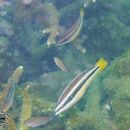en
names in breadcrumbs


The yellowtail tubelip (Yellowtail Tubelip wrasse or Diproctacanthus xanthurus), is a species of wrasse native to coral reefs of the western central Pacific Ocean near Palau, Indonesia, Great barrier reef, Philippines and New Guinea at depths from 3 to 25 m (9.8 to 82.0 ft). The juveniles act as cleaner fish, while the adults primarily prey on coral polyps. The D. xanthurus species grows to a total length of 10 cm (3.9 in). It can be found in the aquarium trade. This species is the only known member of its genus.[2] Other common names for the yellowtail tubelip are cleaner wrasse, Wandering cleaner wrasse, yellowtail wrasse, lulukdayan etc.[3]
The yellowtail tubelip has a clear white and dark brown striped body with a total of 9 dorsal fines, 9 to 10 Doral soft rays, 2 anal spines, 9-11 anal soft spines and 25 vertebrae.[4][5]
The yellowtail tubelip (Yellowtail Tubelip wrasse or Diproctacanthus xanthurus), is a species of wrasse native to coral reefs of the western central Pacific Ocean near Palau, Indonesia, Great barrier reef, Philippines and New Guinea at depths from 3 to 25 m (9.8 to 82.0 ft). The juveniles act as cleaner fish, while the adults primarily prey on coral polyps. The D. xanthurus species grows to a total length of 10 cm (3.9 in). It can be found in the aquarium trade. This species is the only known member of its genus. Other common names for the yellowtail tubelip are cleaner wrasse, Wandering cleaner wrasse, yellowtail wrasse, lulukdayan etc.